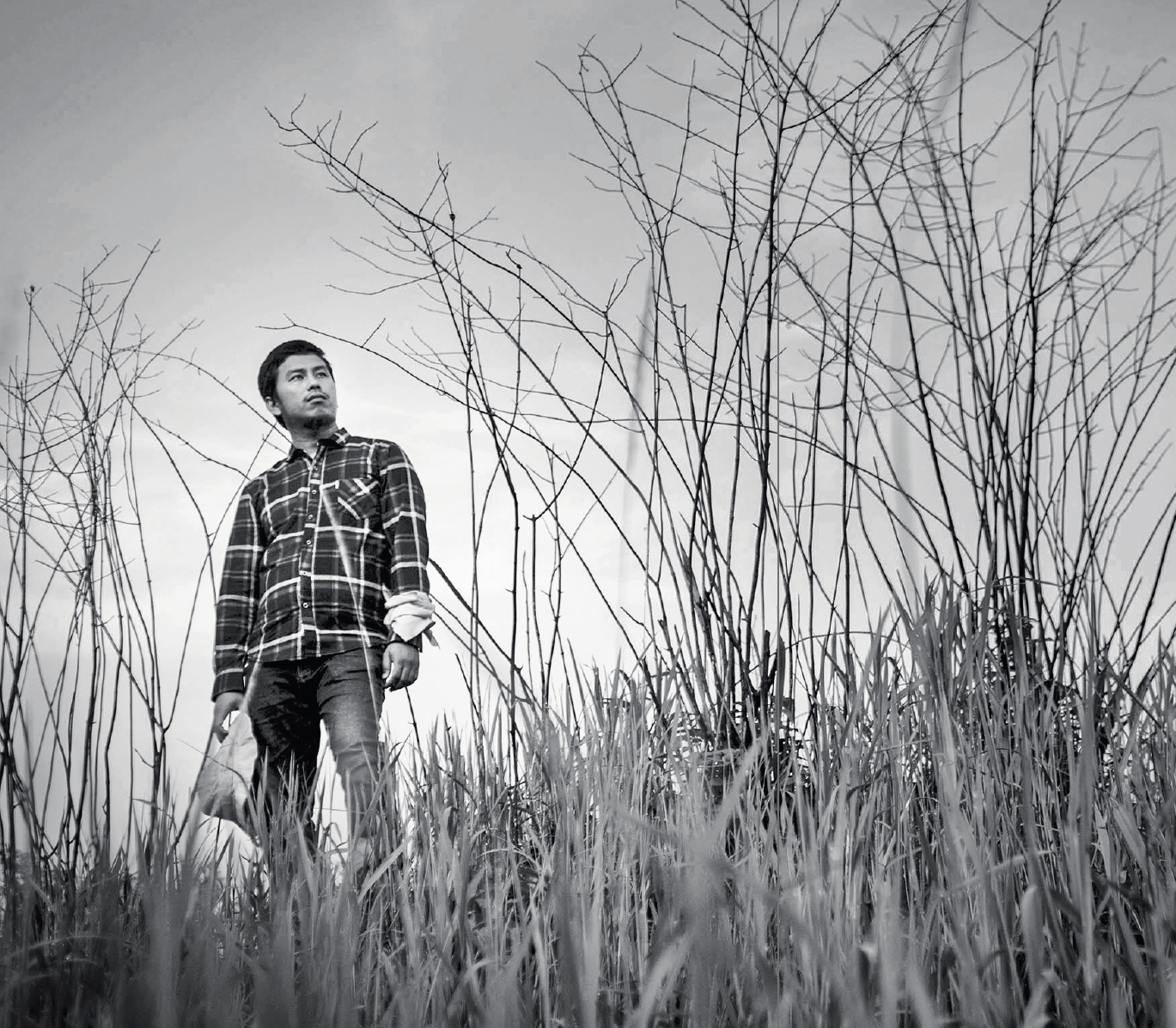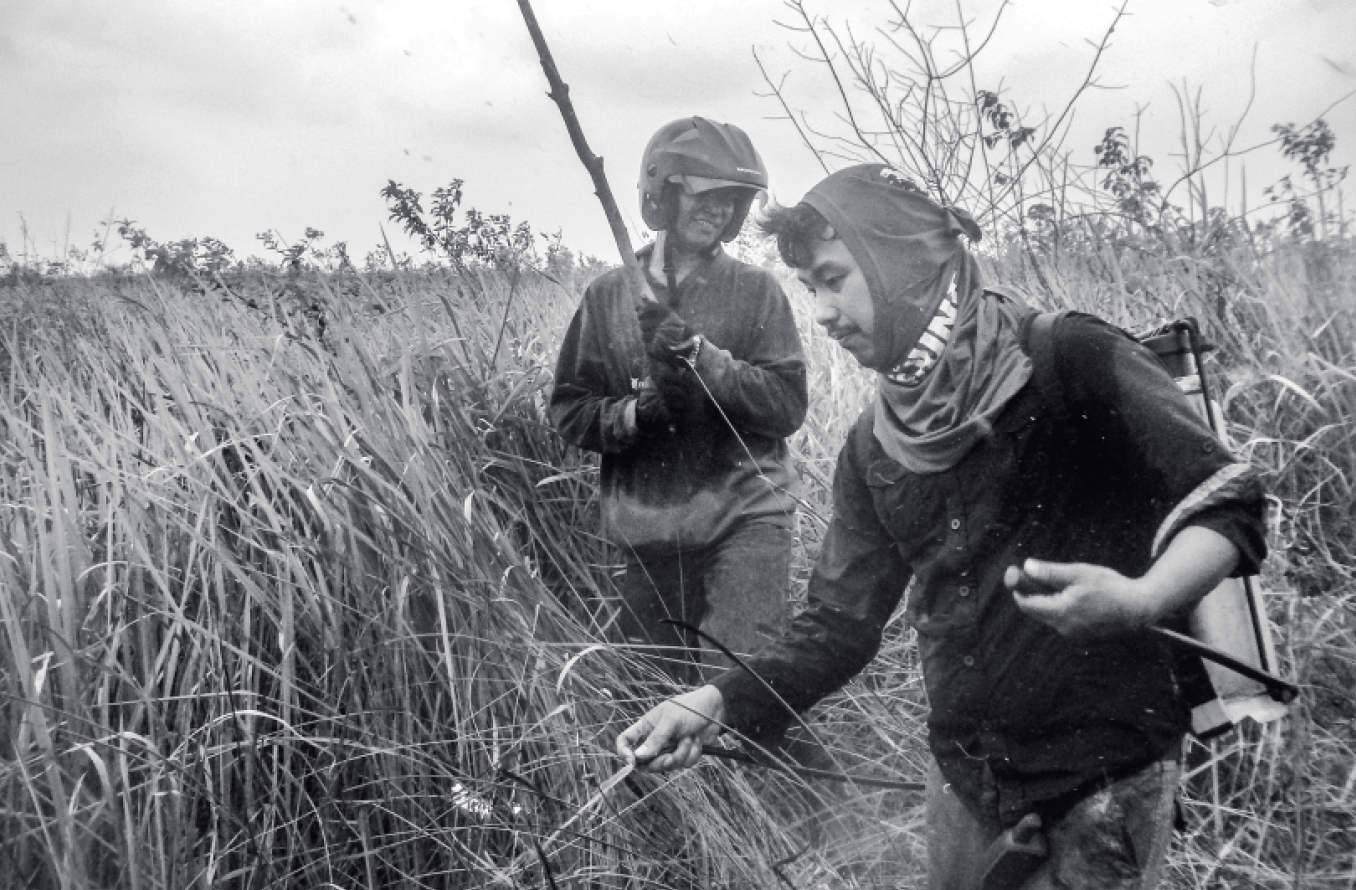
Fajar Sandhika and his team fought fires that were ravaging a weed-tangled field at Rawa Kadut in Way Kambas National Park, Lampung. Their work saved some 22,000 trees in a 100-hectare reforestation program.

Tempo Magazine January 3, 2016 edition.
SMOKE billowed up at the southeast end of the Rawa Kadut reforestation camp at Way Kambas National Park in Lampung, August 9. It was 9am. Fajar Sandhika, reforestation coordinator at the Silvagama Foundation, and his colleague Arum Mutasim moved quickly to check out the source of the blaze. Hopping on a motorbike, they sped down a trail through dense foliage.
At the location, they assessed that the fire was heading west and would probably pass a spot across the Kadut river behind the camp. Since the wind was not blowing hard, they estimated the fire would reach it after 12pm. Fajar and Arum raced back to the camp.
“When we reached camp, we were quickly assigned tasks,” Fajar told Tempo at Rawa Kadut two weeks ago. Three colleagues tried to break the fire’s path at the logistics road. Fajar and Arum had to go to Bungur, the closest neighborhood, to get more help and to coordinate with the Bungur Park management.
Later, Fajar and Arum again sped off on the motorbike down a 12-kilometer, wind- ing path through tall grass and another kilometer through dense forest. Before reaching Bungur, they had to cross the Sukadana river on a wooden raft and travel along a levee. In Bungur, they managed to recruit three people willing to help.
Junior Superintendent of the Forest Police, Firefighting Coordinator for Way Kambas National Park
ON the way back, they saw that the fire was some four kilometers from the Mataram camp belonging to AleRT, the Integrated Forest Conservation Alliance. This meant that in less than three hours, the fire had spread seven kilometers from the spot they had first seen.
The team fought the fire with water pumps and branches cut from trees. The fire was finally out by 5:15pm. They also succeeded in putting out a fire on 2.5 hectares of reforestation area. Exhausted, when they got back at around 8:45pm, another fire was spotted east of the camp. The team went right back to work, extinguishing the fire some 45 minutes later.

Fajar team members extinguish a fire in Rawa Kadut, Way Kambas National Park, Lampung, 9 August 2015
All through August to October, the team at Silvagama Foundation discovered this was their additional work: keeping watch over the area, putting out fires and preventing flames from spreading. Fajar’s real job is actually doing reforestation work.
The Silvagama Foundation, established on November 12, 2009, is involved in nature conservation work. At Way Kambas National Park, Silvagama works with the AleRT Consortium to carry out reforestation projects. AleRT gets its funding from the Tropical Forest Conservation Action for Sumatra (TFCASumatra).
Silvagama manages a reforestation area of about 100 hectares at Rawa Kadut, with a planting time frame of three years. The area is part of the Bungur SPTN II section of the national park. More than 9,200 trees were planted in the reforestation program started on February last year. Their target is to plant 31,200 trees in three years. The trees planted are Schima wallichii evergreens, Peronema canescens evergreen bushes and Eugenia, which are all known to hold up well after forest fires. While above-ground trunks may be scorched, their roots survive and sprout new green branches in time. This is what Tempo saw at Rawa Kadut two weeks ago.
“Our first plot of land was consumed by fire last year,” said Silvagama founder Timer Manurung. The area is fire-prone. Most of the fires are set by the community who believe burning makes the soil fertile and to flush out wild life, making them easier to hunt. Timer tasked Fajar to do the replanting and to control any fires. Fajar has been on duty since November 2014.
Date of birth: Pandeglang, February 22, 1986
Education:Informatics and Computer Studies, Mathla’ul Anwar University, Banten
Organisasi:- Student Nature Lovers Club
(Primapala) of Pandeglang,
High School No.4
- Nature Conservation
Student Association
(Himala), Mathla’ul Anwar
University, Banten
Auriga Nusantara Foundation (previously the Silvagama Foundation) (2011-to date)
Coordinator, TFCA-Sumatra AleRT Consortium Program.
When Fajar arrived on December a year ago, he decided not to wait for the fires to spread. He and his team quickly set up a fire break one kilometer long and 30 meters wide at Rawa Kadut. A fire break is land cleared of plants to halt the progress of fires. “I want to stop all the fires, so we don’t get a repeat of what happened last year, when we lost almost all our reforestation work,” he said.
Fire breaks are effective in fighting fires when resources are limited. Last October, a fire broke out in the area at around at 3pm. Fajar, Arum and the team worked hard to put it out. However, it was too big and their equipment was limited. They decided to use the fire breaks to prevent the fire from reaching the reforestation area. That day, the team worked until 2am. At around 10am, another blaze was spotted west of camp but was quickly extinguished.
“It’s great working with Fajar. We coordinate well,” said Arum, whose job is to maintain contacts with residents of Bungur. Suharno, a forest police superintendent who coordinates firefighting operations at the Way Kambas National Park, agreed, as did AleRT coordinator Rama Budhiana and Mukhlisin, the Bungur section chief.
“Every week, four or five of our guys work with Fajar and his team to keep guard and handle fires,” said Mukhlisin, “Fajar and his friends are great workers.”
The total land scorched by fire at Way Bungur last August came to about 1,500 hectares. By October, 2,000 hectares were totally damaged. Nevertheless, Fajar and his team’s rapid response has saved about 22,000 evergreen trees and shrubs planted by Silvagama on its 22.8 hectares of reforestation land.

Memulihkan ekosistem Way Kambas sehingga menjadi habitat yang aman dan nyaman bagi satwa setempat, seperti gajah, harimau, badak.